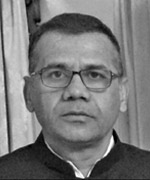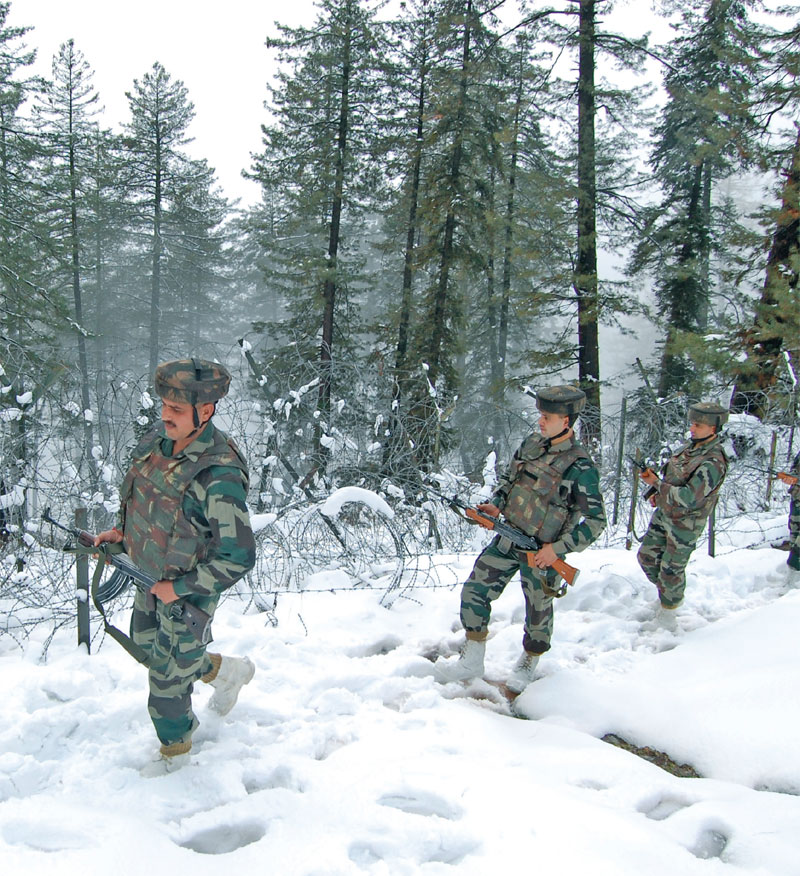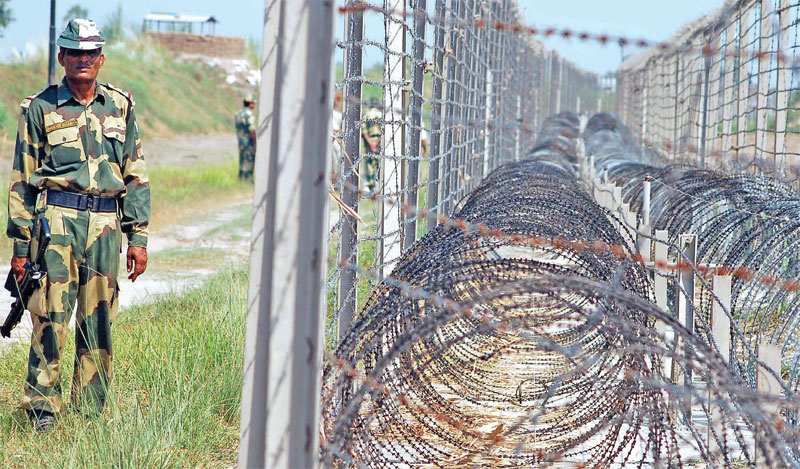Border management needs both technological and HR reforms
 R.C. Sharma
R.C. Sharma
In an 18 March 2022 article in The Tribune newspaper, home minister Amit Shah is quoted as having said that India’s 15,000km-long land border with seven nations has a different challenge every 50 km, as also numerous opportunities. The challenges make border guarding dynamic and requires intense personnel training. The creation of the department of border management in January 2004 was a positive step, but as Madhav Godbole former home secretary said, this was not followed by ‘action on the pertinent issues”.
Border management and human resource policies must have compatibility to produce motivated border guards. For that human resource policies of border guarding forces need to be sensitive to acute stagnation and high attrition in the forces. High attrition is bi-product of faulty human resources management and affects efficiency and causes stress. Efficient human resource management will make border-guarding more effective.
Both border management and human resource management structures need revolutionary reforms through understanding the stakeholders, their strengths, weaknesses and conflicts, and the present status of cooperation and coordination. Unless stakeholders truly integrate, there cannot be impregnable border guarding. The main stakeholders are the forces themselves, the border population and civil administration.
Border Guarding Forces: Border guards are the main stakeholders of border management. They execute border security on ground, ensure security and territorial integrity of our international borders and providing security to the border population. The main constraints in border guarding are underdevelopment, hostile and inaccessible terrain and presence of large tracts of agricultural land ahead of fencing, in addition to hostility from counterpart. Border guarding is distinct from policing and matters military. Human resource management must be made more result oriented through technology intensive and less stressful methods.
Border Population: Locals inhabiting border areas are important stakeholders of border management. Borders have hostile terrain, harsh, jarring and cruel conditions due to infrastructural deficiencies and lack of basic amenities like medical facilities, education, clean drinking water, uninterrupted power supply, connectivity and employment opportunities. In addition, border population is susceptible to border criminals, indoctrination by terrorists, drug menace, counterpart threat, shelling and firing. Borders need development at par with mainland. It is only when border areas are developed and deficiencies addressed that border population will feel emotionally integrated with border guarding forces. Border security must be made less intrusive for locals through technology integration to monitor their movements.

Local Administration: Local administration, especially the police, can play a very vital role in strengthening border security through realistic and real time intelligence sharing and rendering needful cooperation to border guarding forces. Also important is the effectiveness of the administrative apparatus to develop border areas, which will wean away locals from activities.
Border Management Inadequacies
The 214th report of parliamentary standing committee on home affairs highlighted border guarding inadequacies, which included deployment in difficult geographical and climatic conditions, personnel management, pay and pension, stagnation and attrition across various ranks, the structural and psychological disconnect across the ranks, training and capacity building, inadequate infrastructure, lack of basic amenities and medical facilities, grievance redressal mechanism, coordination between the state police forces and CAPFs and the procurement of arms, ammunitions and combat-ready equipment.
The report found a contradiction between the submission of DG, SSB that all BOPs have RO water filter systems and the data furnished by the ministry that around 134 BOPs do not have any type of water filter system. The Committee rapped the Ministry for its failure to provide clean drinking water to SSB personnel at more than 20 per cent of the BOPs. ‘The high incidence of water-borne diseases, with more than 3,000 cases every year, is evidence of this failure’. In ITBP, ‘in 82 per cent of the BOPs, drinking water is obtained from rivulets and springs, which are polluted, and at some places, the level of contamination is alarming’.
For effective border guarding, of foremost interest is accommodation at border outposts (BOPs). The overall housing satisfaction level as per 214th report of parliamentary standing committee is not very encouraging. The availability of dwelling units against the sanctioned strength is 19.25 per cent in AR, 17 per cent in SSB,13.4 per cent in ITBP and 34.4 per cent in BSF.
Rajya Sabha Parliamentary standing committee on home affairs in 203rd report also observed the poor condition of the border outposts. Only 422 out of 1901 BOPs on India-Bangladesh and India-Pakistan Borders were composite and others lacked various basic elements. Several BOPs did not have even the most essential facilities like provision for filtered drinking water or proper barracks; jawans had to live and sleep without a fan in the BOPs. The committee recommended that ‘the Ministry should intensify its efforts for converting all BOPs into composite ones and apprise the committee, periodically, about the progress of this project’.
There is a priority need to replace gadgets that have outlived their utility and acquire modern gadgets like Tunnel detection equipment, HHTIs, tractors, grass cutters and others as these will reduce the burden of border guards and compensate the acute shortage of manpower due to large scale vacancies. As per 224th report of Parliamentary standing committee of ministry of home affairs, there are total 1,03,367 vacancies (11 per cent) in CAPFs. These vacancies generally remain constant since recruitment cycle takes more than two years to complete and high attrition rate nullifies the recruitment. Recruitment must be handed over to the respective CAPFs (presently with the SSC) to expedite the process and bring it down from present two year plus cycle to six to nine months. This will certainly improve manpower position and strengthen border guarding.
Rest and Relief: Stress is the bi-product of inadequate rest and relief coupled with other domestic and professional irritants. The 203rd report of Rajya Sabha standing committee on home affairs observed that that the flawed system leaves grossly insufficient time for jawans to get decent rest and sleep. The Committee wass concerned to note that due to shortage of manpower, jawans are forced to perform 16-18 hours of duty in a day. The BSF needs to ensure at least one gap of eight to 10 hours between two consecutive shifts, as a patrolling shift of six hours is unduly long and without adequate rest a jawan cannot be expected to remain alert throughout the shift. The Committee recommended that this system should be rationalized by creating six shifts of four hours each during a 24-hours cycle wherein a jawan performs two shifts of four hours each in a day with a gap of 8 to 10 hours between these two shifts. It must be ensured that the jawan gets right hours of sleep plus two hours to attend to his personal needs. The ministry should assess the amount of additional manpower required to adopt this system and should have sufficient number of reserve battalions.
Hostile Population: The failure to integrate border population into border management has led to conflict with people on the borders, who consider border-guarding forces as hindrance due to restriction on movement of farmers and others. The border areas on Indo-Pakistan, Indo-Bangladesh and Indo-Nepal border are densely populated, underdeveloped and economically backward. Owing to various factors, some among locals indulge in smuggling for huge profit. The following are recommended for integrating border population into border management:
- Designate at least 20 km of area along the international boundary (IB) as special zone for development–not to be confused with BADP.
- Designate senior most officer/ commandant of border guarding force as nodal officer and chairperson of committee in his area of responsibility for identification of development projects along with district magistrate.
- Panchayat and Block Development Officers be co-opted as members of committee.
- Identify projects, prepare proposals and submit to ministry of home affairs through respective force Headquarters for placement of budget directly with battalions. Projects executed through central agencies must be implemented under supervision of respective forces, with clear timeline for clearance and execution.
Uncooperative Local Administration: Local administration generally are reluctant to share intelligence with border guards and portray them negatively due to desire to retain supremacy. Attempts are made to demoralise border guards by trying to hinder their functioning. Conflict becomes open when different political parties are in power in states and the Centre. The conflict has become more open after extension of jurisdiction of BSF from 15 to 50 km in Punjab, West Bengal and Assam. West Bengal hit out at the Union government for its October 11 decision.and directed the state’s police to not allow BSF personnel to enter villages without their permission. There is a tendency in Punjab police to browbeat and demoralise BSF through charges of non-cooperation. SSP Faridkot went to the extent of blaming the BSF for the escape of a cross border drug smuggler due to non-cooperation, though the accusation was denied by BSF. The fact of the matter is that BSF goes out of its way to cooperate with all agencies in controlling drug smuggling and strengthening national security.
Recommendations
The following recommendations are made to increase professionalism, reduce conflict between border management components, and lower physical and mental health problems culminating in incidents of suicides and fratricides.
Restructure HR Policy: The basic purpose of efficient human resource management is to maintain a motivated force with high morale. The 214th report of Rajya Sabha standing committee expressed its concern that there is excessive stagnation in the non-gazetted ranks of BSF especially at the level of constable. The constable is able to get his first promotion after a long duration of around 20 years, effectively allowing one promotion in an entire career, forcing thousands of constables to opt for voluntary retirement after 20 years of service. Cadre review, which started in November 2015, is pending at the force level and has not reached the MHA. The ministry must urgently find a way out for expediting the process. The cadre review is still pending even after more than seven years. Following is recommended:
- The cadre review ordered in 2015 and not implemented until 2022 has become infructuous. It must be cancelled, fresh review ordered and implemented within six months.
- Restore the rank of Lance Naik and Naik to overcome stagnation, strengthen regimentation and professionalism.
Armed forces strength is about 16 lakh. As per ministry of defence website, there are about 20 joint secretaries in department of defence and department of military affairs and also domain experts of the rank of joint secretary. In CAPFs, decision-making on human resource issues fall in the domain of ministry of home affairs. The strength of CAPFs is a million plus. The home ministry structure dealing with human resource policies of CAPFs is highly inadequate and lacks professionalism forcing CAPF men and officers to approach courts.
The hierarchical structure to deal with CAPFs is Joint Secretary Police-II (CAPFs), followed by directors and Director (R&R) to look after grievances of CAPFs. Generally, one section officer deals with two CAPFs. The joint secretary Police (II) is overworked, cannot pay attention to important HR issues which affect million plus CAPFs and about twelve thousand plus officers of CAPF cadre. There are large number of cases concerning promotions and HR issues in courts. MHA apparatus dealing with HR issues of CAPFs needs restructuring by creating the post of Secretary (CAPFs) under home secretary. His secretariat should have at least one additional secretary. Create separate BSF/ CRPF/ ITBP desks. Each desk should be headed by cadre officers from each CAPF of the rank of IG called as JS/ IG(BSF)/ CRPF to filter proposal received from respective CAPFs on human resource issues and provide professional advice to additional secretary (CAPFs) concerning HR matters.
The joint secretary/IG looking after respective CAPF desk should also have at least two CAPF cadre officers of the rank of DIG/commandant from each CAPF. The system will lead to speedy and correct decision-making on HR issues and usher in professionalism in CAPFs.

Trim Unwieldy Battalion Structure: Trim the unmanageable and unwieldy battalion structure. For professional management reduce the battalion structure to half of current organisational structure of battalion which means division of one battalion into about two battalions. Review company structure for effective command. Each service company should have at least two officers of the rank of deputy commandant and assistant commandant to act as company commander and company second-in-command. Similarly, Support company structure needs review in consonance with for operational needs.
Restore Training: Training in border guarding forces is biggest casualty of non-core commitments. Border guarding forces need to restore realistic ground specific training for mandated role. Restart exercises with army for wartime role and all field commanders up to frontier level must be part of those field exercises. In addition, ensure commanders and staff officers starting from battalion and higher headquarters take part in exercise and war games. Also work out inventory management for occupation of battalion defended area by BSF battalions. Army need to ensure that battalions earmarked for wartime role are integrated for training with Army.
A wrong impression has gained ground that the border guarding forces will have very limited role during war. The BSF has definite wartime role but leadership has relegated it for obvious reasons. The BSF played a stellar role during 1971 and Kargil operations and ITBP showed its mettle during conflict with China in Ladakh. One of their own N.C. Asthana IPS, retired additional DG BSF has opined on wartime training of BSF. “While the BSF discharges its peace time role quite well, it is ill-trained and ill-equipped for its war time role of holding ground in the face of military assault”. He further says, “Since the BSF’s inception, however, IPS leadership, purposefully relegated the war time role of BSF to such an extent that it has been forgotten. They did this in order to hide their own ignorance of matters military”.
Weed out Dead Wood
Professionalism means discipline, proper man management and ability to execute role and task effectively. It also encompasses welfare, physical and mental fitness of men and command. Professional ethos and culture have started diluting thus effecting operational profile. The need is to identify unprofessional, physically and mentally unfit to serve and weed out them in the interest of organisational efficiency and national security. However, proper financial package as compensation be worked out for disability contracted during service.
There is immediate need to go into various inadequacies, which have crept into border guarding forces in terms infrastructure, diluted training, slow and poor promotions. This has affected discipline and demoralisation has set in due to non-addressing of concerns of border guarding forces. It is hoped that government and home ministry will take steps for revival of professionalism.

